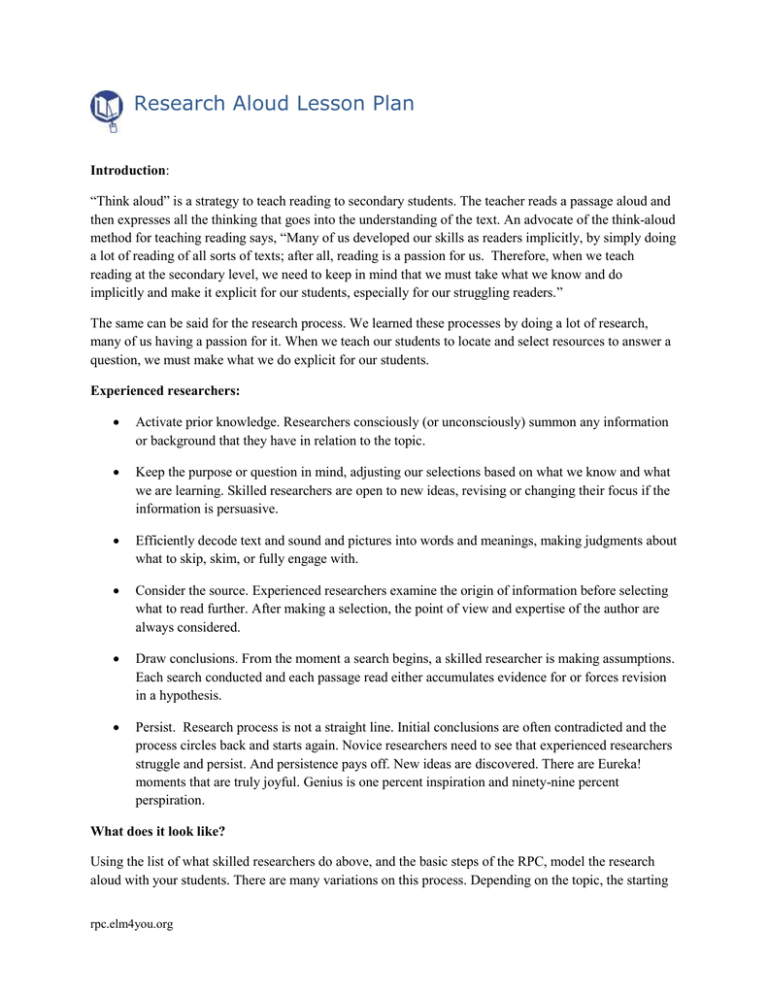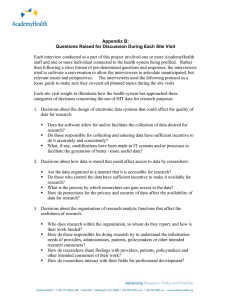Research Aloud Lesson Plan
advertisement

Research Aloud Lesson Plan Introduction: “Think aloud” is a strategy to teach reading to secondary students. The teacher reads a passage aloud and then expresses all the thinking that goes into the understanding of the text. An advocate of the think-aloud method for teaching reading says, “Many of us developed our skills as readers implicitly, by simply doing a lot of reading of all sorts of texts; after all, reading is a passion for us. Therefore, when we teach reading at the secondary level, we need to keep in mind that we must take what we know and do implicitly and make it explicit for our students, especially for our struggling readers.” The same can be said for the research process. We learned these processes by doing a lot of research, many of us having a passion for it. When we teach our students to locate and select resources to answer a question, we must make what we do explicit for our students. Experienced researchers: Activate prior knowledge. Researchers consciously (or unconsciously) summon any information or background that they have in relation to the topic. Keep the purpose or question in mind, adjusting our selections based on what we know and what we are learning. Skilled researchers are open to new ideas, revising or changing their focus if the information is persuasive. Efficiently decode text and sound and pictures into words and meanings, making judgments about what to skip, skim, or fully engage with. Consider the source. Experienced researchers examine the origin of information before selecting what to read further. After making a selection, the point of view and expertise of the author are always considered. Draw conclusions. From the moment a search begins, a skilled researcher is making assumptions. Each search conducted and each passage read either accumulates evidence for or forces revision in a hypothesis. Persist. Research process is not a straight line. Initial conclusions are often contradicted and the process circles back and starts again. Novice researchers need to see that experienced researchers struggle and persist. And persistence pays off. New ideas are discovered. There are Eureka! moments that are truly joyful. Genius is one percent inspiration and ninety-nine percent perspiration. What does it look like? Using the list of what skilled researchers do above, and the basic steps of the RPC, model the research aloud with your students. There are many variations on this process. Depending on the topic, the starting rpc.elm4you.org place may be quite different, but an experienced researcher will usually start with an authoritative source and expand the search in many possible directions. Note: You might introduce the list of what skilled researchers do to your students, or use an inductive process whereby they annotate what you are doing during the research-aloud and then the group or class can create the list together. This may require that air-underline, using a little drama to emphasize important points. (Think air-guitar with a pretend highlighter pen.), Or, you might simply proceed to demonstrate, read out loud and explain each step that you choose. Some of the research aloud will be teaching students how to find a resource and how to use features of the index or search engine, but the ‘why’ is more important here than ‘how’. When you take the students to the library media center or computer lab, you may want to repeat some of the ‘how to’ skills that you will demonstrate. (If you have done some pre-searching related t possible topics your students may raise, you could try this “live” with a topic that the students suggest, but you may want to carefully select these resources to model a particular path.) Unless you have condensed the research process by pre-selecting a question and the articles, these modeling will need to take more than one or two sessions. Step 1: Begin with an explanation of why you have chosen this topic and what you already know. Choose a topic that will illustrate the same process that you students may experience. Explain where you would go first to start your search. This may be very different based on the topic, but experienced researchers will go to a source they can trust to be reliable, to briefly explain what is known about the topic. A general encyclopedia or reference work, print or online, could be very useful for this. Explain how you found the resource, what keywords you selected, why you choose to click through and read a particular item in a search results list. Explain what you learned and what questions were raised. Do these questions take you in a new direction? Did you note any keywords that could be repeated in subsequent searches? Give two or three examples of resources searched for, what you selected from a results list, and why you chose to read (view or listen to) a piece in some depth. Note taking at the stage may be a more like journaling or sketching than using a more organized note-taking process. The goal in this first phase is to model how you took your thinking about a topic to the point of formulating a research question that will guide the rest of your process. You may want to divide the process into several research-aloud sessions. Step 2: In this step, search again with the question in mind. Again, share how you choose the resource, the search tool, the keywords, the reason you selected an item from a results list, and what you decided to read in depth. rpc.elm4you.org As you read a source, explicitly share your thinking processes. For instance, "I wonder what the author means when she says ...." OR "Wait, this seems different than what we read in web site www.xyz.com. I wonder how to decide which author to believe." OR "Because of this information I now believe...and I'm going to change the direction of my search." OR "I rejected Mike's Pretty Good Web Page as a source of information because I could not substantiate the author's credentials." Model your note-taking strategy, explaining why you choose to summarize of quote directly. Explain how you categorize each note or card, and always add enough information to find the source again and prepare for creating a bibliography. Step 3: Skilled researchers will probably arrive at their conclusion during the processes described in Step 2. The categories assigned to the notes will turn into an outline. Not so with novices. Pick a good stopping point. Model brainstorming and sketching, looking for patterns in the ideas and facts you have recorded. Review out loud what you have learned and explain why you believe it to be so. This would be a great chance to show students that researchers sometimes discover that they don’t have an answer. They need more information. They need to return to the search, perhaps changing the focus. If you find an answer, supported with evidence, don’t be shy about shouting Eureka! Model the process of taking the sketches into a more formal outline. This is huge. Take a breather before entering the next phase of developing a product that communicates these ideas to an audience. How could I use, adapt or differentiate it? In his book, Improving Comprehension with Think-Aloud Strategies, Jeffrey Willhelm provides a list of “basic ways to conduct think-alouds.” Could these be adapted to research-alouds? You decide. Teacher does research-aloud; students listen. Teacher does research-aloud; students listen. Teacher does research-aloud; students help out. Students do research-alouds as large group; teacher and other students monitor and help. Students do research-alouds in small group; teacher and other students monitor and help. Individual student does research-aloud in forum; other students help. Students do research-alouds individually; compare with others. (they write their commentary) Teacher or students do research-alouds orally, in writing, on an overhead, with Post-it notes, or in a journal. The above is presented with honorable credit or apologies to the author/s of the English Language Arts Home Page on the Greece Central School District in New York web site. Connect to this page to find many constructivist teaching ideas. http://www.greece.k12.ny.us/instruction/ela/ The specific URL for the information on read-aloud paraphrased above go to: http://www.greece.k12.ny.us/instruction/ela/6-12/Reading/Reading%20Strategies/thinkaloud.htm rpc.elm4you.org

